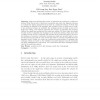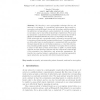193 search results - page 19 / 39 » Fair Public-Key Cryptosystems |
STOC
2005
ACM
14 years 8 months ago
2005
ACM
Our main result is a reduction from worst-case lattice problems such as GAPSVP and SIVP to a certain learning problem. This learning problem is a natural extension of the `learnin...
EUROCRYPT
1998
Springer
13 years 12 months ago
1998
Springer
Abstract. This paper introduces a cryptographic paradigm called selfescrowed encryption, a concept initiated by kleptography. In simple words, a self-escrowed public-key cryptosyst...
CARDIS
1998
Springer
13 years 12 months ago
1998
Springer
In this paper we describe new secure personalization schemes using proxy cryptography. We first introduce the context of a large scale smart card application such as an electronic ...
PKC
2007
Springer
14 years 1 months ago
2007
Springer
: This paper addresses the security of optimistic fair exchange in a multi-user setting. While the security of public key encryption and public key signature schemes in a single-us...
CTRSA
2004
Springer
14 years 1 months ago
2004
Springer
We introduce a new cryptographic technique that we call universal re-encryption. A conventional cryptosystem that permits reencryption, such as ElGamal, does so only for a player w...


